|
How to Research ~Beginners |
|
Basic Steps for Starting Genealogy Research |
| 1. Start by recording what you know about yourself. Write down your own name, birth date, place of birth, parents, grandparents, husband or wife, if married, date of marriage, place of marriage, children's complete names and their dates of birth. This includes talking to relatives to find out what they may know to help fill in info about your family, as much as possible. Get as much info as you can about your family that will be of help in knowing who, when and where they lived. All of this is in preparation before you get into doing actual research with online records. |
| 2. Look for family records at home or from relatives, such as bibles, funeral home obituaries, military records, old photos, birth, marriage or death records from older family members, etc., anything that contains information that can help in your research. Write these things down in a notebook, a document on your computer, or whatever else that will be handy and accessible to you to refer to at any time. Be prepared to make a record, a citation, of where you found a document or resource, and include that information along with that specific document so that you and anyone else can easily find that same information again. |
| 3. Now that you have Names, and hopefully some ideas of locations where they lived, it's time to start looking for your family in Census Records which exist every 10 years starting from 1790 and are available to the public currently up to 1950. Start with the 1950 Census, looking for your most recent ancestor who was born prior to that year, using their last known location or the birth location, if you have it. Follow your ancestors back every 10 years through the Census, building a Chart for each generation you find. When using Census records, make sure you look at the actual images, record all of the information found in them, and make note of the families surrounding them for several pages both before and after your ancestors. Most often, those neighbors were also related to them, so it is a good idea to keep a separate list of those names with their info, so that you can revisit them later to do some research on who they were, too. Pay attention to what each column in the Census says, they varied each year, and there is great information to be found in them. Download blank copies of Census forms to help you read & understand those columns. |
| 4. Once you've learned these basic steps, it's important that you follow-up each of the individual ancestors with additional records for each step in their lives, that is, find Birth, Marriage & Death Records, which will help identify spouses and children to further research. Keep in mind that many States, North Carolina for instance, did not have Birth & Death Certificates until 1913, and that most Southern States had similar time periods, but North Carolina has recorded Marriage Records since 1741, although the vast majority of those early records are not found for every County that existed during that time period, so always read & study about the Locations your ancestors lived in, learn the history of those places, the State, the County; look at maps to see where they lived, and the names of the surrounding Counties and States. Don't just go into research without some basic understanding of where and how people lived in your ancestors time. And most importantly, document and include citations for everything in your tree, attach copies of all documents and save as many of those as possible to your own offline files. |
| I suggest that you use Family Group
Sheets, Pedigree Charts or a Genealogy Program software to keep your
files organized and to build your family tree. As your research grows,
you'll appreciate having all of your information together and more
easily managed using a Genealogy software program on your computer, where you may
also create your own Charts and Trees to share with your family, as well
as a GEDCOM to save copies as backups, or to transfer to other genealogy
software, or to an online tree. Some are free some are fairly expensive,
but it is best to see which is the best to fit your budget. As info, the most widely used software
are FamilyTreeMaker, RootsMagic, and Legacy Family Tree, but there are
others which are also available. I suggest that new users post messages
in online Message Boards or your Facebook groups for recommendations & opinions from others about their
experiences with what they may use. Even if you are building your tree on a site like Ancestry, FamilySearch, Wiki Trees or some other website, it is advisable that you keep a copy of your tree on genealogy software on your computer or other device. |
| An entire array of free genealogy
charts and forms can be downloaded for free here: Free Charts and Forms |
| Keep these sites handy, they are the census instructions given for each census year: |
| U.S. Census Instructions 1790-2020 |
| U.S. Enumerators Instructions 1850-1950 |
| Some sites that have Census
and other Records for Researching
are: FamilySearch.org, a free website with lots of free genealogy records of all kinds. Sign up for a free account to get access to images. FamilySearch Records Search As with any site, there is a
learning curve for searching on FamilySearch, so check out this article
from them.
A Beginners Guide to Searching Records If you decide to use Ancestry.com, please make sure that you read
their tutorials in how to research on their site.
Getting
Started with Family Trees Check with your local library website to see if they offer Heritage Quest.
Also, some libraries across the country offer use through the purchase
of cards from them for a fee, so if your local library doesn't offer HQ,
check other libraries for their policies in offering cards for those
outside of their area. The Best Genealogy Tools for 2024 You may also want to read through this article: How to Choose the Best Genealogy Software
|
| Visit either of
these websites for guides to help you research: FamilySearch’s Learning Center, Beginners Genealogy free online video courses Getting Started with Genealogy from the North Carolina State Library
Additionally, our NCGenWeb Stateline home page has plenty of
resources, grouped by kinds of records which you can explore whenever
you like.
NCGenWeb Statewide
Information |
| As stated in the title here, this is only a basic step to start your research, so don't stop with just these suggestions. Read books on researching, join local genealogy societies, go to genealogy workshops, visit websites which offer research videos; if you're a Facebook user, check out links to such resources which are always being posted on genealogy-related Facebook pages, including our own NCGenWeb Project Facebook Group. |
| See also: A Basic Guide to Start Researching Enslaved People |


